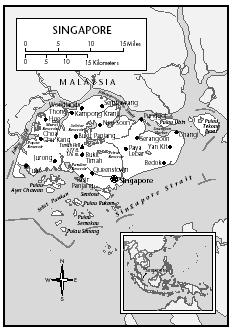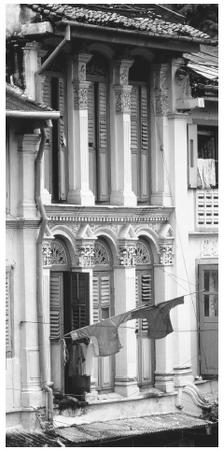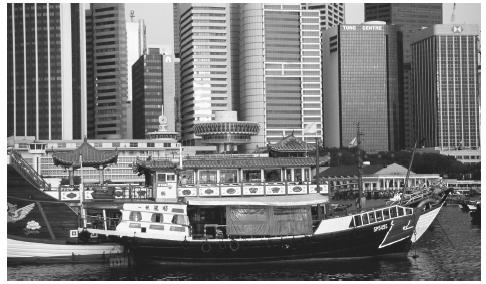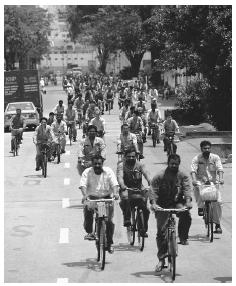Singapore
Culture Name
Singaporean
Orientation
Identification. The place name "Singapore" is derived from Singa-pura ("City of the Lion"), a commonly used term since the fourteenth century. The main cultural traditions are Malay, Indian, Chinese, and to some extent Western (British). The different communities do not regard themselves as sharing a culture; instead, they consider themselves parts of a whole. This is illustrated by reference to a popular local dish, Rojak , a salad in which the various ingredients are covered by the same peanut sauce, forming a distinct whole with each ingredient clearly discernible. The peanut sauce is Singaporeanness; the other ingredients are the different cultural traditions.
Location and Geography. Singapore lies at the tip of the Malay peninsula. It borders Malaysia, Indonesia, and Brunei. Its area is 248 square miles (642 square kilometers), including the main island and some sixty islets. The main island is flat with a hilly region in the middle. The highest point is Bukit Timah, feet (206 meters) above sea level. The climate is tropical with high humidity and abundant rainfall, especially during the northeast monsoon in December to March. The period of the southwest monsoon (June to September) is usually the driest.
The main island is fully urbanized with a dense commercial city center to the south. Around the city center are new townships that house about 86 percent of the population. The townships are self-contained and have high-rise apartment blocks, shops, medical and social service buildings, religious buildings, and schools; they are well connected by the Mass Rapid Transport System (MRT), which circles the island.
Demography. Singapore has a population of about three million, 2.7 million of whom are citizens and permanent residents. The other three hundred thousand are mainly foreign workers. The Chinese constitute about 78 percent, the Malays 14 percent, the Indians 7 percent, and others 1 percent of the population. The ethnic composition of the population has been relatively stable.
Linguistic Affiliation. Singapore is a multilingual state. The national language is Malay, and the four official languages are Malay, English, Indian (Tamil), and Chinese (Mandarin). English is the administrative language and the medium of instruction in schools. Pupils also choose one of the "mother tongues": Malay, Tamil, and Chinese. There are various subdialects of the different languages.
Symbolism. Economic prosperity and political stability are associated with the national culture, as is the Singaporean concept kiasu . Kiasu means "afraid to lose" and refers to the wish to come in first in lines, competitions, negotiations, and so forth. Some say kiasu keeps standards high, but others claim it leads to a graceless society.
The flag is divided into equal red and white horizontal sections symbolizing unity and purity. A white crescent moon and five stars in a circle symbolize a growing nation and the ideals of democracy, peace, progress, justice, and equality. The national anthem and national motto are in Malay. Other symbols draw on the distinct ethnic traditions. Chinese, Malays, and Indians draw on symbolic materials and ritual practices from their own traditions and for their own purposes.
History and Ethnic Relations
Emergence of the Nation. Singapore emerged as a nation after 1965. For nearly one hundred fifty years it had been a British colony that was intimately linked to the whole Malay peninsula. Singapore

National Identity. There is no single dominant national identity. Instead, there are complex identities that draw on a variety of sources and are relevant in different situations, although ethnic identity takes precedence in most situations.
Ethnic Relations. Cultural links to India, China, Malaysia, and Indonesia give Singaporeans orientations and loyalties that stretch far beyond the national borders. These differences are superseded by an identification with Singapore as a homeland with wealth and stability. Distance and distinction mark ethnic relations within the country.
Urbanism, Architecture, and the Use of Space
Singapore is a green city, but it has a very groomed greenness. There are two small national parks. Only at the fringes of the island and on the islets is there rural life, and it is disappearing fast. Highways crisscrossing the island, the huge port on the southern tip, vast industrial areas to the west, and the airport to the east create an air of swift efficiency.
The most striking features of the landscape are the high-rise buildings. This is a distinctly modern architecture with roots in the functionalism of the 1960s. In the 1980s and 1990s, there was more diversity in building styles. The typical domicile is a small apartment off the ground. Ethnicity is not an issue in the public use of space; communal differences are clearly discernible in the layout of the interiors of homes and certain town areas.
Food and Economy
Food in Daily Life. Rice, fish, chicken, and vegetables are the staples. When these ingredients are mixed with a rich variety of spices, chilis, coconuts, lime, and tamarind, the variations are endless. Food is often eaten outside the home in food centers where food is cheap, tasty, and freshly made. There are many cafés, coffeehouses and teahouses, and formal restaurants. Forks and spoons are used, but Chinese food is eaten with chopsticks, and Indian and Malay food may be eaten with the hand. The three main meals are breakfast, lunch, and dinner. Most meals are eaten hot. Malays do not eat pork, Indians do not eat beef, and many Buddhist Chinese are part-time vegetarians. Many people do not drink alcohol.
Food Customs at Ceremonial Occasions. Special dishes are eaten during the major ceremonial occasions of all three ethnic groups, but none are connected to national celebrations.
Basic Economy. Singapore has a fully developed industrial international economy. The country depends heavily on imports, as there are few natural resources on the island. There has been a consistent surplus in the overall balance of payments. There is a large degree of state control of the economy.
Land Tenure and Property. There is a large degree of private ownership of houses and apartments. Land tenure is firmly regulated by the government and there are government plans for the use of every inch of the island's territory. Foreigners usually are allowed only to lease land, but they may buy apartments.
Commercial Activities, Major Industries, and Trade. Manufacturing is the most important economic sector, followed by financial and business services, commerce, transportation, and communications. Production is mainly for export. The main exports are electronics, refined petroleum products, natural rubber, and palm oil. The main trading partners are Malaysia, the European Union (EU), the United States, Hong Kong, and Japan.
Division of Labor. About two-thirds of the resident population is employed. Only 0.2 percent of the members of the workforce are employed in the primary sector, and about 37 percent of employed persons work in commerce and finance and the business sector. Twenty-three percent work in manufacturing, 21 percent in other services, and 18 percent in transportation and communications and construction. The unemployment rate has long been below 3 percent but increased during the recent economic downturn. Chinese are over-represented in professional, technical, administrative, and managerial jobs, whereas Malays are the most underrepresented in highly skilled jobs, with Indians in the middle. The substantial numbers of foreign workers are overrepresented in production and related work.
Social Stratification
Classes and Castes. There are wide income and wealth differences, but the country is more differentiated by ethnicity than by class. All the ethnic groups have experienced upward occupational mobility. There is an intense focus on education. Good marks are a sure path to good positions with good wages. In this respect, Singapore is a meritocracy.

Symbols of Social Stratification. Singaporeans jokingly refer to their desire for the "five C's": car, condominium, credit card, club membership, and career. These are important symbols of wealth and status regardless of ethnicity. There is no national costume, but the orchid is used as a national symbol, and textiles with orchid patterns may be employed as a national symbol on formal occasions.

Political Life
Government. Singapore is a republic with a parliamentary system. The head of state is the president, who is elected for a fixed term of six years. The parliament is elected in a general compulsory election every five years. There are also six nominated members of the parliament. The cabinet is the executive organ of the state, and execution of government policies is carried out by ministries and statutory boards.
Leadership and Political Officials. The People's Action Party (PAP) has maintained a large majority in the parliament since 1965, with only a few seats held by politicians from opposition parties. The road to a political position through the cadre system of the PAP lies in educational and professional merit as well as loyalty. The other parties are led by politicians with strong personalities.
Social Problems and Control. The crime rate is low. The judiciary system is based on the British legal system. The death penalty is imposed for drug smuggling, and caning is still used as a punishment. In addition, there are fines or other penalties for a wide range of transgressions, such as throwing litter on the floor, urinating in the elevator, and engaging in politics outside registered political parties.
Military Activity. Both military and civil defense are well developed, and the armed forces are equipped. Two and a half years of compulsory military service are required for males.
Social Welfare and Change Programs
Social welfare is financed through the Central Provident Fund (CPF), a public savings scheme. Employees under age 55 and their employers contribute a fixed amount of a worker's salary into an individual account administered by the CPF. This account provides financial security for old age and can be drawn on for housing and medical and educational costs. Charity is an important aspect of the financing of social welfare. Care of the old, sick, and disabled is in the hands of families and relatives. Three different agencies provide some social services for members of the three ethnic groups. Independent social work units also carry out some social work.
Nongovernmental Organizations and Other Associations
Many of the nearly five thousand registered societies are directly or indirectly linked to the government. Among the rest, very few can be defined as

Gender Roles and Statuses
Nearly 80 percent of men and about 50 percent of women are employed. Women have joined the workforce in large numbers but are underrepresented in leadership positions in all areas and institutions.
Marriage, Family, and Kinship
Marriage. Polygamy is allowed among Muslim Malays, but otherwise monogamy is the rule. Interethnic marriages are not common. Divorce is becoming more common. The average age at first marriage has increased, and it is customary for young people to live with their parents until they marry.
Domestic Unit. The basic household unit is the nuclear family, which constituted 85 percent of resident households in 1990. Close links with relatives on both the husband's and the wife's sides are usually maintained. The proportion of households without a family nucleus shrank from 26 percent in 1957 to 8 percent in 1980, reflecting the changes from an immigrant to a settled population. Males dominate as heads of households.
Inheritance. Traditionally, sons inherited family assets, while daughters were expected to marry out of the family. This pattern is less common today.
Kin Groups. Kin groups play a significant role in all ethnic groups, and people often move within wide networks of relatives. Privately, kin groups are important, but politically and economically, they play a marginal role.
Socialization
Infant Care. Children are brought along in most situations except business and very formal events. Small children are showered with affection. Generally, children are expected to be quiet and obedient and may be physically punished for misbehaving. There is very little free space where children can play and few areas designed specially for children.
Child Rearing and Education. Children are thought to hold the key not only to their own future but also to the future of their families, and education is regarded as extremely important. There is a range of private and public nurseries, kindergartens, and play schools. Children start school at age six.
Higher Education. There is a great emphasis on higher education. Children spend six years in primary school and four years in secondary school and then go on to a vocational school or university, depending on their grades (a sure way to higher education in Singapore) or money (a university education abroad). Competition for entrance to the best schools is fierce.
Etiquette
Older people ideally are treated with respect, but wealth and status may supersede age distinctions. A social superior or an authority is treated with much formality. There are great differences between formal and informal events, situations, and places. In social interaction, a certain physical distance is kept, especially between men and women. Food rules of the ethnic groups are always respected.
Religion
Religious Beliefs. There is freedom of religion with some exceptions. Singapore has been described as one of the most religious countries in the world. The major religions are Islam (Malay), Hinduism (Indians), Buddhism, Taoism, and folk religion (Chinese), along with a substantial number of Christians of various denominations.
Religious Practitioners. Religious experts vary from formally installed priests and teachers representing the institutionalized religions to self-ordained shamans, healers, and sorcerers.
Rituals and Holy Places. The many Chinese and Indian temples, Malay mosques, and Christian churches are the main public arenas for religious activities. Much religious activity is also carried out in the home. There are different "street festivals" according to the ritual calendars of the different ethnic groups
Death and the Afterlife. A funeral is a major ritual for all ethnic group. The idea of an afterlife is generally shared.
Medicine and Health Care
A well-developed modern medical system consists of private and public clinics and hospitals. Traditional medical beliefs and practices are also common.
Secular Celebrations
The national holiday is on 31 August and is celebrated with military parades and culture shows at the national stadium. The ethnic public holidays are divided nearly equally among Chinese, Malay, Indian, and Christian holidays. The most important ethnic holidays are the Chinese New Year and the Malay Muslim Rahmadan, both celebrated in January–February, and the Indian Deepavali or Festival of the Light, celebrated around September–October.
The Arts and Humanities
Literature, Graphic Arts, and Performance Arts. A common complaint is that Singapore has no culture, and the fine arts have a limited public. The government subsidizes some art institutions and events, but generally there is little public funding. The different ethnic groups have their own artistic traditions and focus on arts. The contemporary generation is more focused on contemporary art forms.
The State of the Physical and Social Sciences
Singapore has well-developed scientific institutions. Priority is given to technology and applied science. There are two universities: the National University of Singapore, a full-scale university with all disciplines, and the Nanyang Technical University.
Bibliography
Bloodworth, Dennis. The Tiger and the Trojan Horse , 1986.
Brazil, David. Street Smart Singapore , 1991.
Census of Population , Monograph No. 5. Singapore, 1990.
Cheng, Lim Keak. Geographical Analysis of the Singapore Population , 1995.
Chua, Beng Huat. Political Legitimacy and Housing. Stake-holding in Singapore , 1997.
Clammer, John. The Sociology of Singapore Religion: Studies in Christianity and Chinese Culture , 1991.
Craig, JoAnn. Culture Shock: Singapore and Malaysia , 1979.
Drysdale, John. Singapore: Struggle for Success , 1984.
Hill, Michael, and Kwee Fee Lian. The Politics of Nation Building and Citizenship in Singapore , 1995.
Ho, Kong Chong, and Chua Beng Huat. Cultural, Social and Leisure Activities in Singapore , 1995.
Huff, W. G. The Economic Growth of Singapore: Trade and Development in the Twentieth Century , 1994.
Kuo, Eddie C. Y., and Tong Chee Kiong. Religion in Singapore , 1995.
Lai, Ah Eng. Meanings of Multiethnicity: A Case-Study of Ethnicity and Ethnic Relations in Singapore , 2nd ed., 1995.
Lee, Edwin. "Community, Family and Household." In Chew C. T. Ernest and Edwin Lee, eds., A History of Singapore , 2nd ed., 1996.
Lim, Catherine. Little Ironies: Stories of Singapore , 1978.
Pugalenthi Sr. Elections in Singapore , 1996.
Tamney, Joseph B. The Struggle over Singapore's Soul: Western Modernization and Asian Culture , 1995.
Toh, Mun Heng, and Tay Boon Nga. Households and Housing in Singapore , 1995.
Turnbull, C. M. A History of Singapore, 1819–1988 , 1989.
Yeoh, B. S. A., and L. Kong, eds. Portraits of Places. History, Community and Identity in Singapore , 1995.
—B ENEDICTE B RØGGER
interracial marriages are common in singapore
i think you need to update your information...
And the Muslim fasting month of Ramadan is not in January-February, at least not every year. The starts and ends of Ramadan varies from year to year, always about 11 days earlier than the previous year. The official Muslim holidays in Singapore are Eid Al-Fitri, celebrated after Ramadan, and Eid Al-Adha.
Other important, but unofficial, Muslim religious events include the Maulud, celebrating the Prophet Muhammad's birthday.
Also, not all the Muslims in Singapore are Malays with a sizable being Indians. The Arab community is also Muslim and some Eurasians are also Muslims.
About the segment about Inheritance, what this article said about only sons inheriting is not practice by the Muslim community, which follows the faraid or Islamic inheritance laws where daughters do have inheritance rights.
Also, intermarriage is especially common among Muslims. Malay-Indian intermarriages are very common.
some of the information needs to be reviewed over again & the comments posted by the other users definitely needs to seriously considered.
Men wear batik shirts with orchid prints.
Women wear anything - skirts, blouses, shirts etc - with orchid prints!
Or you can use our colours - red and white - to represent singapore!
WE don't have a national dress, cos we are an amalgamation of so many races, so the "orchid" is our symbol in terms of dress!
Hope that helps!
Chinese: cheongsam/qipao
Malay: baju kurung/baju melayu
Indian: sari
peranakan: kebaya nonya
You can google them, or google traditional chinese/malay/indian/peranakan costume
I really really need the answer!!! thanks!! ^_^
Read more: Culture of Singapore - history, people, traditions, women, beliefs, food, customs, family'
similarities and differences between Singapore and Australia?